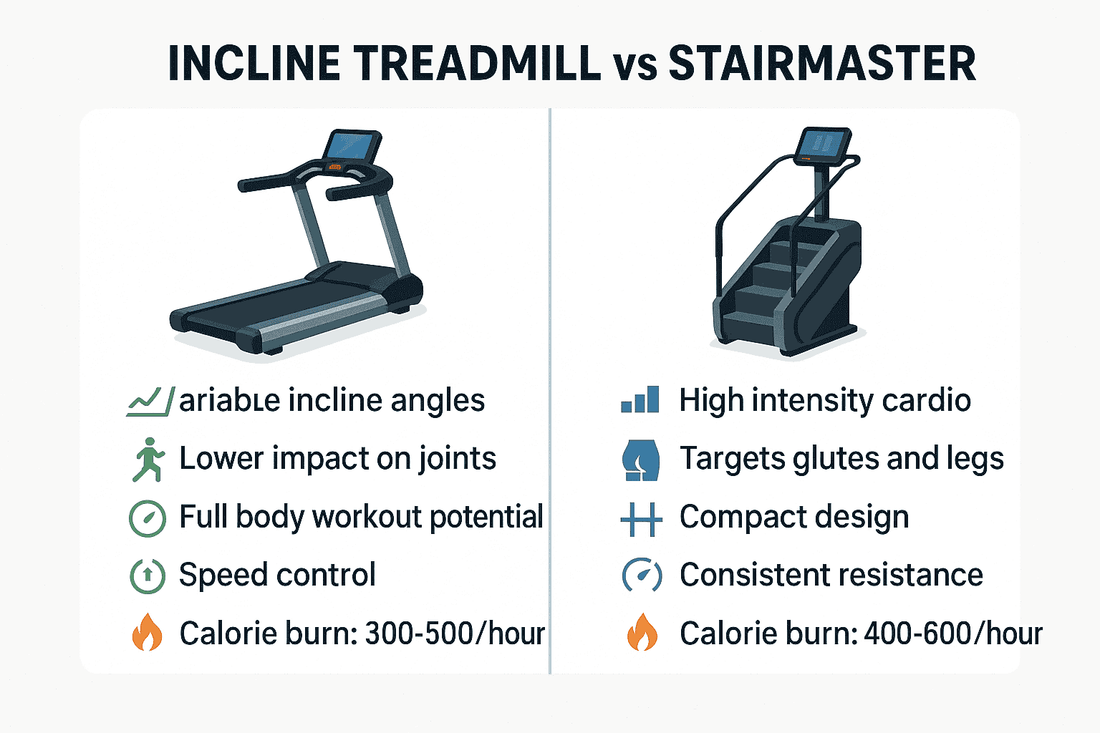
Incline Treadmill vs StairMaster: Which Delivers Better Results?
Share
Q: Which is better — incline treadmill or StairMaster?
A: It depends on your goal. For versatility and longer workouts, an incline treadmill (like Famistar models) wins. For short, intense calorie-burn and targeted glute/quadriceps overload, the StairMaster often delivers quicker results.
Quick intro
Both the incline treadmill and the StairMaster provide low-impact cardio that strengthens the lower body while burning calories.

This guide walks through how each machine works, who benefits most, quick workout examples, and evidence-backed tips so you can decide between an incline treadmill vs StairMaster for your home or gym routine.
How each machine works (what you feel and why)
Incline treadmill walking simulates steep hiking by increasing the treadmill grade, distributing effort across hamstrings, glutes and calves while allowing a natural gait. The StairMaster (a continuous step machine) forces upward stepping per rep, creating greater mechanical overload per step and higher short-term heart response for many users.
Evidence: exercise physiology studies show short bouts of stair climbing improve VO₂max and cardiovascular markers; see an example of stair-climbing intervention research on PubMed Central and an eight-week training study at PMC.
Muscles targeted & cardio impact
Both options recruit quadriceps, hamstrings, glutes, calves and core stabilization when you avoid leaning on rails. Stair climbing typically produces higher heart-rate responses at matched durations, which helps explain its time-efficient cardio benefits (see Cleveland Clinic's guide on stair climbing benefits).
Trusted reading: Cleveland Clinic's feature on stair-climbing benefits is a useful practical reference: 7 Stair-Climbing Benefits.
Top benefits of an incline treadmill
- Highly versatile—walk, power-walk, jog, or run with incremental incline.
- Great for long steady-state cardio and progressive overload across time.
- Often easier to progress for beginners and people rehabbing joints.
- Use incline walking to support bone density and endurance (ACE Fitness guidance explains how incline walking scales intensity).
Top benefits of the StairMaster
- Time-efficient calorie burn and strong glute/quadriceps activation.
- Perfect for HIIT-style short workouts and metabolic boosts.
- Improves balance and vertical power through repeated stepping.
- Can be lower-impact than running, though knee flexion increases with tempo—practical notes in Cleveland Clinic coverage.
Quick side-by-side
| Metric | Incline Treadmill | StairMaster |
|---|---|---|
| Calorie burn | Adjustable—high when incline & pace increase | Often very high for short durations when intensity is high |
| Joint impact | Lower at walking pace; increases if running downhill or fast | Low-to-moderate; repeated bending of knees is a factor |
| Muscle emphasis | Balanced across hamstrings, glutes, calves | Higher per-step load on quads & glutes |
| Use case | Endurance & hiking prep; home cardio | Time-efficient HIIT and glute-focused work |
| Beginner-friendliness | Easy to ramp | Requires an adjustment period |
Choose by goal (short guide)
Best for fat loss or calorie burn
Either will work if intensity and duration are comparable. For short, intense efforts the StairMaster can be more efficient; for sustainable longer sessions, incline treadmill walking at a steady pace often wins.
Best for glute and leg tone
The stair-stepping motion tends to overload glutes and quads per rep—so the StairMaster is excellent for targeted leg tone. High incline walking on a treadmill can achieve similar engagement if you increase grade and stride force.
Best for joint-friendly cardio
If you need low-impact, slow-and-steady incline walking on a treadmill is a gentle way to build endurance. ACE Fitness offers guidance on stair-climbing benefits and how to choose safe intensities for people with joint concerns.
How to use the Famistar incline treadmill (smart, safe, effective)
If you're choosing a home machine, the Famistar incline treadmill is designed for easy incline programming and progressive training. Try these practical sessions:
- Incline interval (30 min): 5 min warm-up flat, 3 × (5 min at 8–12% incline walking, 2 min flat recovery), 5 min cool-down.
- Endurance walk (45 min): Keep incline at 5–8% and a brisk walking pace to promote stamina and fat oxidation.
- Combine with stairs: Add one StairMaster session each week or do a 10-minute StairMaster finisher after your treadmill work for variety and metabolic boost.
Sample StairMaster workout (10-8-4, beginner→advanced)
- Warm-up: 5 minutes easy flat walking.
- Main: 10 min steady moderate, 8 min at higher pace, 4 min max sustainable pace (reduce if new to the machine).
- Cool-down: 5 minutes easy walking + calf & hamstring stretches.
Practical tips (applies to both)
- Avoid holding rails tightly—use them for balance only; letting your arms swing increases calorie burn and core engagement.
- Measure intensity by heart rate or RPE (rate of perceived exertion), not only machine readouts.
- Mix intervals and steady state to improve both aerobic power and fat-burning capacity.
- Gradually increase time and intensity to reduce overuse injuries; early research shows measurable VO₂max benefits from short-bout stair training programs.
Frequently asked questions
Is an incline treadmill better for fat loss than a StairMaster?
Not inherently—calorie burn depends on intensity and duration. Many find StairMaster more time-efficient, while others prefer the sustainability of incline treadmill walks.
Which is easier on the knees?
At low intensities incline walking on a treadmill is often gentler. Rapid stair stepping involves repeated knee flexion and can feel tougher for some; always test both at low intensity first.
Can beginners use a StairMaster?
Yes. Start slow, hold rails lightly, and gradually build stepping time and cadence. Transition to lighter hand support as balance improves.
Conclusion
In the incline treadmill vs StairMaster question there’s no universal winner — the right pick is the one that matches your goals and that you’ll stick with. Choose Famistar incline treadmill if you want versatility and easy progressive programming at home; use StairMaster sessions for time-efficient intensity and concentrated lower-body overload. Alternating both gives you the best of both worlds.

